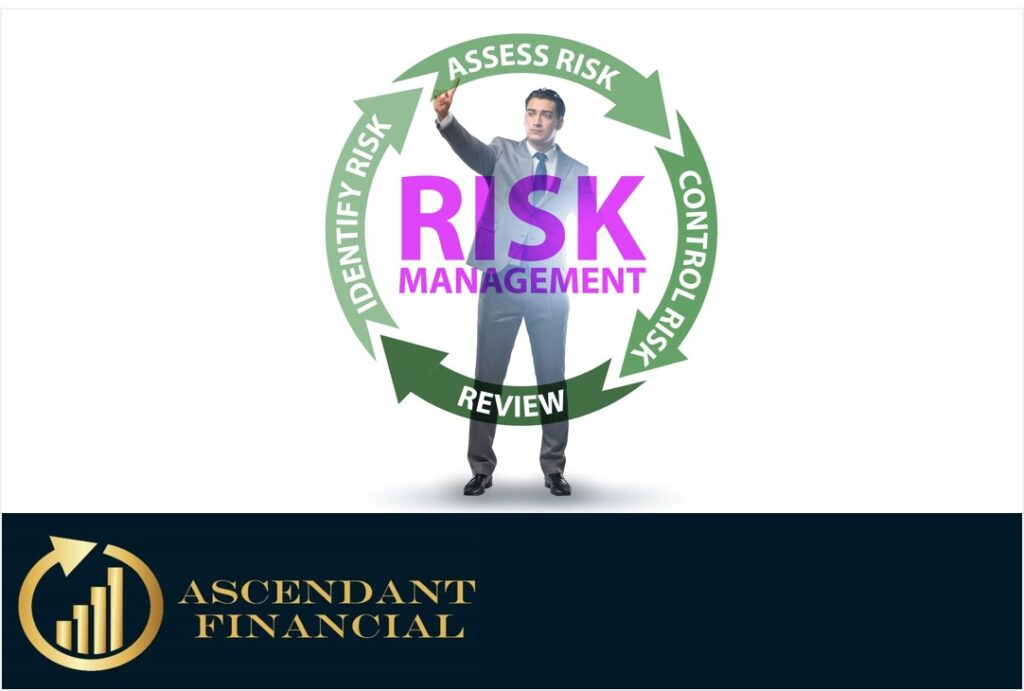
Risk management is an integral aspect of financial advisory services, ensuring individuals and organizations navigate the complex landscape of investments and finances with prudence and strategy. A financial advisor's role encompasses various critical elements, including risk assessment, investment diversification, and insurance planning. These professionals meticulously evaluate financial risks, taking into account clients' unique circumstances and objectives.
One of the fundamental pillars of risk management is investment diversification. Prudent Advisors recommend their Clients strategically spread investments across a range of assets, such as stocks, bonds, and real estate, reducing exposure to the volatility of any single investment. This diversification approach aims to optimize returns while minimizing the impact of market fluctuations, aligning with the principle of risk mitigation.
Insurance planning is another vital component of risk management. Life Licensed Advisors assess Clients' insurance needs, ensuring they are adequately protected against unforeseen events, address any terminal tax obligations, complete the estate planning process, and develop a preferred retirement solution. This also involves recommending suitable life, health, and property insurance policies, creating a financial safety net to shield against potential financial crises.
Portfolio management plays a pivotal role in risk management as well. Advisors construct and oversee investment portfolios tailored to clients' risk tolerance and financial goals. This includes ongoing monitoring and adjustments to maintain an optimal balance between risk and return.
Financial planning, at its core, is about creating comprehensive strategies to achieve clients' objectives while understanding and factoring in their unique risk tolerance. Advisors work closely with clients to chart a course towards financial security and growth. This often involves assessing risk tolerance, identifying potential risks, and implementing risk mitigation strategies.
Beyond these attributes, financial advisors must navigate the complex landscape of market risk management, regulatory compliance, retirement planning, estate planning, tax efficiency, and economic risk analysis. These facets of risk management are interwoven into a comprehensive approach aimed at securing financial futures and optimizing wealth accumulation.
[toc]Risk management is a fundamental core process in the realm of financial advising. It refers to the process of identifying, assessing, and mitigating potential risks that individuals or organizations may encounter in their financial endeavors. A financial advisor plays a pivotal role in guiding clients through this process, helping them make informed decisions to safeguard their financial resources. Effective risk management involves a comprehensive analysis of various factors, including market fluctuations, economic conditions, and individual risk tolerance. By understanding and managing risks proactively, individuals can strive to achieve their financial goals with confidence, even in uncertain times.
Risk assessment is a cornerstone of a financial advisor's responsibilities. It involves a meticulous evaluation of a client's financial situation, goals, and tolerance for risk. Through this assessment, financial advisors gain valuable insights into the client's unique risk profile, enabling them to tailor investment strategies and financial plans accordingly. By identifying potential risks and their potential impact, advisors can offer guidance on mitigating these risks effectively. This proactive approach helps clients make informed decisions that align with their risk tolerance and financial objectives. In essence, risk assessment forms the foundation for creating a robust financial plan that considers and manages risks for the client's financial well-being.
Investment diversification is a crucial strategy in risk management when working with a financial advisor. It involves spreading investments across a range of asset classes, such as stocks, bonds, real estate, and more. By diversifying a portfolio, the risk is spread across a variety of asset classes. When one asset class experiences fluctuations or losses, other components of the portfolio can potentially offset those losses, preserving overall capital. Financial advisors recommend diversification as a means to balance risk and return, aiming for optimal performance while mitigating the impact of market volatility. Diversified portfolios can provide clients with a more stable and resilient investment strategy, enhancing the chances of achieving their long-term financial goals.
Insurance planning holds significant importance in the realm of financial advising, particularly in risk management, tax mitigation, estate planning and wealth creation. Financial advisors recognize that tax risk, market risk, liquidity needs, unexpected events, such as accidents, illnesses, or natural disasters, can have a profound impact on an individual's financial security. Therefore, advisors assess clients' insurance needs and recommend appropriate coverage, which may include life insurance, health insurance, property insurance, and more. These insurance policies serve as a financial safety net, protecting clients and their families from unforeseen financial burdens. The role of insurance planning is to ensure that clients have the necessary coverage in place to navigate challenging situations without depleting their savings or jeopardizing their financial goals. In essence, insurance planning is a critical component of risk management, providing peace of mind and financial security for the future.
Portfolio management is a central aspect of risk management when working with a financial advisor. This process involves the selection and ongoing monitoring of investments within a client's portfolio. A financial advisor carefully curates a diversified portfolio that aligns with the client's risk tolerance and financial objectives. Additionally, the advisor continuously evaluates and adjusts the portfolio to adapt to changing market conditions and the client's evolving financial situation. The goal of portfolio management is twofold: to optimize returns and to mitigate risk. Advisors strive to strike a balance between these objectives, ensuring that the portfolio can weather market fluctuations while working towards the client's financial goals. Through expert portfolio management, financial professionals help clients achieve long-term financial success while managing risk effectively.
Financial planning is a cornerstone of risk mitigation when working with financial advisors. It involves a comprehensive assessment of a client's financial situation, goals, and risk tolerance. By understanding these factors, financial advisors can create a tailored financial plan that not only aims to achieve objectives but also addresses potential risks. Financial planning incorporates strategies to mitigate risks, such as proper insurance coverage, investment diversification, and emergency funds. This proactive approach helps clients navigate uncertain financial terrain with confidence, knowing that they have a structured plan in place. In essence, financial planning not only provides a roadmap to financial success but also serves as a shield against unexpected challenges, contributing significantly to risk mitigation in the realm of financial advising. It is recommended that one work with a Certified Financial Planner, or Chartered Life Underwriter.
Risk tolerance assessment holds immense significance for financial advisors. It involves gauging an individual's willingness and capacity to accept financial risk in their investments and financial decisions. By understanding a client's risk tolerance, advisors can tailor their recommendations to align with the client's comfort level. This assessment guides the advisor in creating a portfolio and financial plan that balances risk and return appropriately. For clients with a low risk tolerance, advisors may recommend conservative investments that prioritize capital preservation. In contrast, those with a higher risk tolerance may explore more aggressive investment strategies. Risk tolerance assessment ensures that clients' financial strategies are well-suited to their individual preferences, enhancing the overall effectiveness of risk management.
Financial advisors recommend several key risk mitigation strategies to their clients. These strategies include diversifying investments, creating an emergency fund, maintaining proper insurance coverage, and regularly reviewing and adjusting financial plans. Diversification helps spread risk across various asset classes, reducing the impact of poor performance in any one area. An emergency fund provides a financial cushion in case of unexpected expenses or income disruptions. Adequate insurance coverage protects against unforeseen events, such as medical emergencies or property damage. Regular reviews and adjustments of financial plans ensure that strategies remain aligned with changing circumstances and financial goals. These strategies collectively form a robust approach to mitigating risks and preserving financial stability.
Financial advisors play a pivotal role in helping clients manage market-related risks. They continuously monitor financial markets and economic conditions, providing timely advice and recommendations. When market conditions become volatile or uncertain, advisors can guide clients on making informed decisions, such as adjusting investment portfolios or adopting defensive strategies. Financial advisors also educate clients about the nature of market risks and the potential impacts on their investments. By fostering a clear understanding of market dynamics, advisors empower clients to make rational decisions, reducing the likelihood of impulsive or fear-driven actions that could harm their financial goals. Additionally, advisors often incorporate diversified investment strategies to minimize the impact of market fluctuations. Through these measures, financial professionals act as a crucial line of defense against market-related risks, helping clients navigate turbulent financial waters with confidence.
Regulatory compliance is of utmost importance in risk management for financial advisors. Financial markets are subject to a large amount of regulations and standards designed to protect investors and maintain market integrity. Financial advisors must adhere to these regulations to ensure ethical and legal practices. Compliance measures encompass transparent disclosure of fees, potential conflicts of interest, and adherence to fiduciary duties. By complying with these regulations, financial advisors uphold the highest standards of professionalism and client protection. Failure to do so can result in legal consequences and reputational damage. Regulatory compliance is not only a legal requirement but also a fundamental aspect of risk management, safeguarding clients' interests and maintaining the integrity of the financial advisory profession.
Retirement planning is integral to risk management in the context of financial advising. It involves creating a structured financial plan that ensures clients are well-prepared for their retirement years. By meticulously assessing a client's retirement goals, income sources, and expenses, financial advisors can design a strategy that mitigates the risk of outliving one's savings. Retirement planning often includes strategies for wealth preservation, tax efficiency, and creating a reliable income stream during retirement. With careful planning, financial advisors help clients navigate the potential risks associated with retirement, such as market volatility and inflation. The ultimate aim is to provide clients with financial security and peace of mind in their post-retirement years, demonstrating how proactive retirement planning contributes significantly to comprehensive risk management.
Estate planning is a critical component of risk management for financial professionals. It involves strategizing the orderly transfer of assets and wealth to intended beneficiaries upon a client's passing in the most tax advantaged way. Proper estate planning not only ensures that the client's wishes are upheld but also helps mitigate potential risks, such as estate taxes and disputes among heirs. Financial advisors work with clients to create wills, trusts, and other instruments that protect assets and facilitate a smooth transition of wealth. By addressing potential risks and uncertainties in advance, estate planning safeguards the client's financial legacy and minimizes the likelihood of costly legal battles or unintended consequences. It exemplifies how financial professionals take a holistic approach to risk management, considering long-term implications and protecting clients' interests beyond their lifetime.
Tax efficiency plays a significant role in risk management strategies recommended by financial advisors. By optimizing tax planning, advisors help clients minimize the erosion of wealth due to taxes. Tax-efficient strategies can include tax-deferred investments, tax-free income sources, and strategic timing of asset sales. These strategies not only enhance the overall after-tax returns on investments but also mitigate the risk of unexpected tax burdens. Additionally, tax-efficient planning can contribute to the preservation of wealth and the achievement of long-term financial goals. Financial advisors incorporate tax efficiency as a fundamental aspect of risk management, ensuring that clients retain more of their hard-earned money and are better positioned to achieve financial security.
Economic risk analysis is essential when managing risk with the guidance of a financial advisor because it provides insights into broader economic trends and potential impacts on financial goals. Financial advisors closely monitor economic indicators, such as inflation rates, interest rates, and GDP growth, to assess economic risk. By understanding these factors, advisors can make informed recommendations and adjustments to clients' financial strategies. Economic risk analysis helps clients prepare for potential economic downturns, fluctuations in currency markets, and changes in consumer spending patterns. This proactive approach ensures that clients' financial plans are resilient to economic uncertainties, demonstrating how economic risk analysis is a cornerstone of comprehensive risk management in the realm of financial advising.
For more information about Risk Management for Financial advisor contact the team at Ascendant Financial today.









© 2024 Ascendant Financial Inc. All rights reserved.
The supporting material, audio and video recordings and all information related to Introduction to Becoming Your Own Banker, The Infinite Banking Concept (IBC) posted on www.ascendantfinancial.ca and all other Ascendant Financial Inc. websites are designed to educate and provide general information regarding The Infinite Banking Concept (IBC) and all other subject matter covered. It is marketed and distributed with the understanding that the authors and the publishers are not engaged in rendering legal, financial, or other professional advice. It is also understood that laws and practices may vary from province to province and are subject to change. All illustrations provided in these materials are for educational purposes only and individual results will vary. Each illustration provided is unique to that individual and your personal results may vary. Because each factual situation is different, specific advice should be tailored to each individual’s particular circumstances. For this reason, the reader is advised to consult with qualified licensed professionals of their choosing, regarding that individual’s specific situation.
The authors have taken reasonable precautions in the preparation of all materials and believe the facts presented are accurate as of the date it was written. However, neither the author nor the publishers assume any responsibility for any errors or omissions. The authors and publisher specifically disclaim any liability resulting from the use or application of the information contained in all materials, and the information is neither intended nor should be relied upon as legal, financial or any other advice related to individual situations.
Family Banking System (FBS)™ is a trademark of Ascendant Financial Inc. © Ascendant Financial Inc., 2024. All rights reserved. The phrase “Live the Lifestyle, Love the Process, Infinite Banking” is a registered copyright (Registration No. 1209863) with the Canadian Intellectual Property Office. Unauthorized use, reproduction, distribution, or copying of this phrase, in whole or in part, without express written permission from Ascendant Financial Inc. is strictly prohibited. This copyright is protected under Canadian intellectual property laws and regulations. Any unauthorized use is subject to legal action and enforcement under Canadian law. For inquiries or requests for permission to use this copyright, please contact Ascendant Financial Inc.
The Infinite Banking Concept® is a registered trademark of Infinite Banking Concepts, LLC. Ascendant Financial is independent of and is not affiliated with, sponsored by, or endorsed by Infinite Banking Concepts, LLC.”
This content is intended for Canadian residents of BC, AB, SK, MB, ON, NB, NS, NU, YT, PEI & NFLD only.